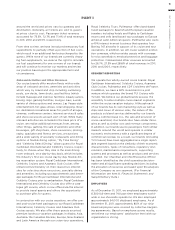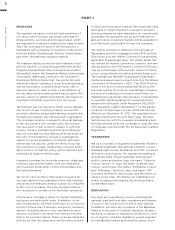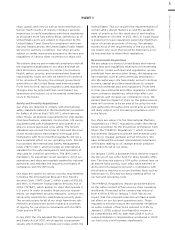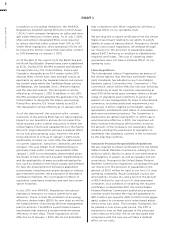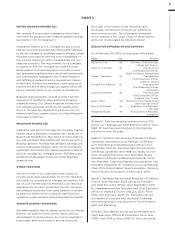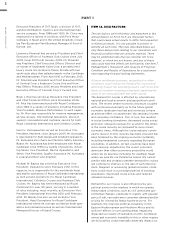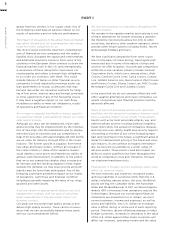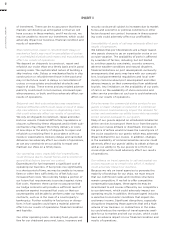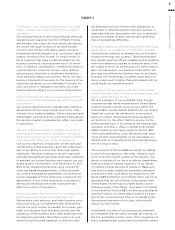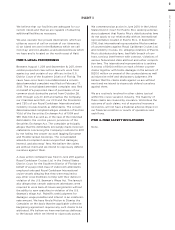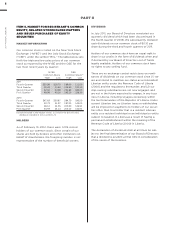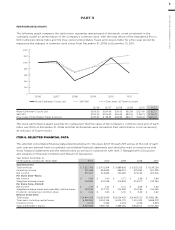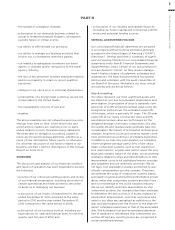Royal Caribbean Cruise Lines 2011 Annual Report Download - page 34
Download and view the complete annual report
Please find page 34 of the 2011 Royal Caribbean Cruise Lines annual report below. You can navigate through the pages in the report by either clicking on the pages listed below, or by using the keyword search tool below to find specific information within the annual report.
2011 ANNUAL REPORT 30
PART I
goods from key vendors in our supply chain. Any of
the foregoing could have an adverse impact on our
results of operations and on industry performance.
The impact of disruptions in the global financial markets
may affect the ability of our counterparties and others
to perform their obligations to us.
The recent severe economic downturn, including fail-
ures of financial service companies and the related
liquidity crisis, disrupted the capital and credit markets
and additional economic concerns from some of the
countries in the European Union continue to strain the
financial markets both in the U.S. and internationally.
A recurrence of these disruptions could cause our
counterparties and others to breach their obligations
to us under our contracts with them. This could
include failures of banks or other financial service
companies to fund required borrowings under our
loan agreements or to pay us amounts that may
become due under our derivative contracts for hedg-
ing of fuel prices, interest rates and foreign currencies
or other agreements. If any of the foregoing occurs
it may have a negative impact on our cash flows
including our ability to meet our obligations, results
of operations and financial condition.
An increase in capacity worldwide or excess capacity
in a particular market could adversely impact our cruise
sales and/or pricing.
Although our ships can be redeployed, cruise sales
and/or pricing may be impacted both by the introduc-
tion of new ships into the marketplace and by deploy-
ment decisions of ourselves and our competitors. A
total of 20 new ships with approximately 62,000 berths
are on order for delivery through 2016 in the cruise
industry. The further growth in capacity from these
new ships and future orders, without an increase in
the cruise industry’s share of the vacation market,
could depress cruise prices and impede our ability to
achieve yield improvement. In addition, to the extent
that we or our competitors deploy ships to a particu-
lar itinerary and the resulting capacity in that region
exceeds the demand, we may lower pricing and prof-
itability may be lower than anticipated. Any of the
foregoing could have an adverse impact on our results
of operations, cash flows and financial condition
including potentially impairing the value of our ships,
goodwill and other assets.
If we are unable to appropriately balance our cost
management strategy with our goal of satisfying
guest expectations it may adversely impact our
business success.
Our goals are to provide high quality products and
deliver high quality services. There can be no assur-
ances that we can successfully balance these goals
with our cost-containment efforts.
We may lose business to competitors throughout the
vacation market.
We operate in the vacation market and cruising is one
of many alternatives for people choosing a vacation.
We therefore risk losing business not only to other
cruise lines, but also to other vacation operators, which
provide other leisure options including hotels, resorts
and package holidays and tours.
We face significant competition from other cruise
lines on the basis of cruise pricing, travel agent pref-
erence and also in terms of the nature of ships and
services we offer to guests. Our principal competitors
within the cruise vacation industry include Carnival
Corporation & plc, which owns, among others, Aida
Cruises, Carnival Cruise Lines, Costa Cruises, Cunard
Line, Holland America Line, Iberocruceros, P&O Cruises
and Princess Cruises; Disney Cruise Line; MSC Cruises;
Norwegian Cruise Line and Oceania Cruises.
In the event that we do not compete effectively with
other vacation alternatives and cruise companies, our
results of operations and financial position could be
adversely affected.
Fears of terrorist and pirate attacks, war, and other
hostilities and the spread of contagious diseases could
have a negative impact on our results of operations.
Events such as terrorist and pirate attacks, war, and
other hostilities and the resulting political instability,
travel restrictions, the spread of contagious diseases
and concerns over safety, health and security aspects
of traveling or the fear of any of the foregoing have
had, and could have in the future, a significant adverse
impact on demand and pricing in the travel and vaca-
tion industry. As we continue to expand internation-
ally, we become susceptible to a wider range of
adverse events. These events could also impact our
ability to source qualified crew from throughout the
world at competitive costs and, therefore, increase
our shipboard employee costs.
Fluctuations in foreign currency exchange rates could
affect our financial results.
We earn revenues, pay expenses, recognize assets
and incur liabilities in currencies other than the U.S.
dollar, including, among others, the euro, the British
pound sterling, the Canadian dollar, the Australian
dollar and the Brazilian real. In 2011, we derived approx
-
imately 49% of revenues from operations outside the
United States. Because our consolidated financial
statements are presented in U.S. dollars, we must
convert revenues, income and expenses, as well as
assets and liabilities, into U.S. dollars at exchange
rates in effect during or at the end of each reporting
period. Therefore, absent offsetting changes in other
foreign currencies, increases or decreases in the value
of the U.S. dollar against other major currencies will
affect our revenues, operating income and the value



